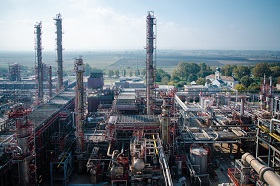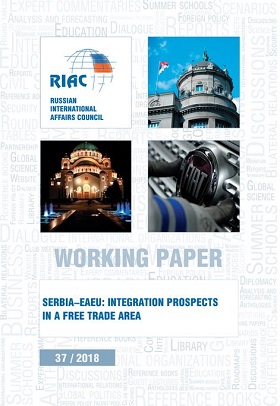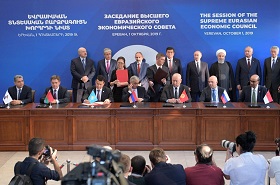The situation in Southeast Europe today is still primarily determined by the attitude of non-aligned states to Euro-Atlantic integration. In this respect, interaction between Russia and the West still has a significant influence on the situation. European countries and the European Union as a whole, as well as the United States, are stepping up their activity in the Balkans in a big way. Russia has also increased its presence in the region, relying to a greater degree on economic and humanitarian cooperation. However, the Balkans remain attractive for other actors as well, with Turkey, China and the Persian Gulf states exhibiting a growing interest in a region. In that respect, it would be useful to explore the influence that external factors have on the situation in the region.
The situation in Bosnia and Herzegovina, as well as that in Kosovo, are of the greatest concern. Nevertheless, there is no reason to expect open military clashes, as the attention of global powers today is focused on the region. What is more, the events of the 1990s into the early 2000s are still fresh in everybody’s memory.
In the near future, the European Union should be expected to step up its activities in the region and attempt to find new models of interaction with the non-member states in the Balkans.
The gaps and hotbeds of tension that have emerged certainly require Russia’s closer attention. Russia can be described as “composing itself” in terms of its policy in the Balkans as it searches for and tries to determine its strategic interests in Southeast Europe in general. We should expect Moscow to step up its cooperation in the region, particularly in the energy sector.
What is more, the specific results of the EAEU–Serbia cooperation can set a positive precedent for other Balkan states.
The situation in Southeast Europe today is still primarily determined by the attitude of non-aligned states to Euro-Atlantic integration. In this respect, interaction between Russia and the West still has a significant influence on the situation. European countries and the European Union as a whole, as well as the United States, are stepping up their activity in the Balkans in a big way. Russia has also increased its presence in the region, relying to a greater degree on economic and humanitarian cooperation. However, the Balkans remain attractive for other actors as well, with Turkey, China and the Persian Gulf states exhibiting a growing interest in a region. In that respect, it would be useful to explore the influence that external factors have on the situation in the region.
At the same time, we can see that internal factors determining the situation in Southeast Europe have also been re-energized. These factors include the crisis of the ruling elites, which to one degree or another affect all countries in the region today. The long-standing ethnic and denominational contradictions persist, and they are accompanied by the radicalization of individual elements in religious communities. At the same time, we see a worsening of social problems caused by unrealized economic objectives and which manifest themselves in the drain of the working-age population and the high unemployment rates.
The so-called “stabilization and destabilization scenarios” in the Balkans had a large hand in predicting the situation in the region.
Stabilization Scenarios: 2016–2019
Broadly speaking, stabilization in the Balkans means the normalization of relations both between the states in the region and between these states and external actors. The key provision of such a scenario is the resolution of the ongoing crisis between Russia and the West. In the Balkans, this crisis manifested itself in a complicated knot of interrelations among Balkan states, the Euro-Atlantic aspirations of certain political elites and the Western powers behind them, and Russia, which relies on traditional cultural and religious ties and economic cooperation.
Politically, the stabilization scenario mostly proved correct. First, the confrontation between Russia and the West abated somewhat. In the Balkans, this development is manifested in the attempts of certain local Euro-Atlantic-minded political elites to normalize relations with Moscow. We are talking in particular here about Montenegro, which, following the events of 2016 (an attempted “pro-Russian coup by GRU agents”) and until recently officially assumed an openly anti-Russian stance. Podgorica joined the sanctions formally, and President of Montenegro Milo Djukanovic repeatedly referred to the Russian threat in his speeches. While this rhetoric was primarily aimed at combating the local pro-Serbian and anti-NATO opposition, which the authorities accused of having ties with the Russian secret services, relations with Russia were undermined for a long time.
Given the unwillingness of Brussels to deepen European integration with Montenegro, as well as the often unpredictable stance of Washington, Podgorica, suffering from economic difficulties and shaken by political scandals, has been actively trying to smooth its relations with Moscow in recent months, sending it friendly signals.
Re-energized talks on the Kosovo problem also play a role in stabilizing the situation in the Balkans. EU attempts to achieve a rapprochement between Belgrade and Pristina in 2018 failed. However, this development created an important foundation for further endeavours in this direction in the future. In particular, a land swap between Kosovo and Serbia is now being discussed in earnest today, which could serve as a potential basis for future agreements.
Moreover, following the parliamentary elections in Kosovo, the United States openly declared that it wanted these talks to be resumed. Washington appointed Matthew Palmer as its Special Representative for the Western Balkans. In early November, Palmer held a meeting with President of Serbia Aleksandar Vučić that resulted in the latter giving his consent in principle to continue the talks.
In the meantime, the Kosovo issue was taken up as part of Pristina–Podgorica relations. Despite the active resistance of the right-wing opposition, the Kosovo–Montenegro border demarcation agreement signed back in 2015 was finally ratified by the Kosovo parliament in March 2018.
Economic, energy and communications forecasts have also been reflected in the current stabilization processes. We are talking primarily about agreements among the Balkan states, as well as with Turkey and Russia on building a gas pipeline as part of the TurkStream project, the first stage of construction of which has already completed. The project was named the Balkan Stream. Per the agreements achieved, the pipeline branch from the Krasnodar Region via the Black Sea that has already been completed will continue through the European part of Turkey to the Bulgarian border, across Bulgaria and on to the Serbian border, where it will turn to Hungary. Phase one of the Balkan Stream was complete as of late October 2019. Moreover, there are talks on the possibility of involving Greece in the project. These developments make it possible to talk about a thaw in Russia–Bulgaria relations and indicate that Russia has gained additional support for its influence in the region.
Nevertheless, Russia is far from being the only actor in the Southeast Europe energy sector. In 2018, construction was completed on the Trans-Anatolian pipeline delivering gas from the Caspian via Turkey to Greece, and the Trans Adriatic Pipeline project owned by Azerbaijani, Belgian, British, Italian, Spanish and Swiss investors was revitalized once again. The project was almost 90 per cent complete as of September 2019.
Thus, as predicted, Southeast Europe has become a crucial transit region for international energy projects. Moreover, since not only Russia but also other gas exporting countries and potential third-country beneficiaries participate in such projects, we may say that the region’s gas supplies are diversified. The absence of a dominant gas supplier indeed stabilizes the situation in Southeast Europe.
Another critical factor is the increasing role that Turkey is playing in the Balkans. Ankara has significantly bolstered its regional standing, stepping up cooperation in several areas at once, including its interaction with Serbia, which is carried out directly between the two heads of state via the High-Level Cooperation Council (HLCC).
Ankara and Serbia signed a series of agreements spanning various areas of cooperation, from economics and education to defence and state-of-the-art technologies. Turkey also financed the construction of the Belgrade–Sarajevo highway and opened a number of enterprises in Serbia. The expansion of the Free Trade Agreement between Turkey and Serbia has helped lay solid foundations for increasing trade turnover.
Similarly, Ankara is working with its traditional protégés in the region, Bosnia and Herzegovina (B&H) and Albania, and in-depth interaction has also been established with Macedonia. These developments allow Turkey to exert its political influence: the Balkan states willingly extradite the fugitive followers of Muhammed Fethullah Gülen, whom Recep Erdogan accuses of the attempted coup in 2016, to Turkey.
China’s investment policy in the region appears particularly prominent. Beijing played an active role in a series of major infrastructure and energy projects in the Balkans. China invests most heavily in Serbia, and its investments have already had a significant effect on the economic situation in the country. The increased debt of the countries in the region to Chinese lenders may be a cause for concern. Nevertheless, it is too early to talk about the total economic subjugation of the Balkans: the European Union remains Southeast Europe’s largest donor, as well as its most significant investment and trade partner.
Serbia is also living up to its predicted central role in the region’s international economic contacts. The increasing role of the Eurasian Economic Union (EAEU) in the Balkans is also noteworthy. The Free Trade Agreement signed by the EAEU and Serbia should both increase Serbian exports and provide potential EAEU investors with access to the region. The agreement makes it clear to the West, Turkey and China that Serbia is open to cooperation in all areas.
Belgrade also follows a pragmatic policy in its military and political cooperation. Serbia has stepped up contacts both with Russia (the Slavic Shield 2019 military exercise and its purchase of Russian weapons) and with NATO states (the Shabla 2019 exercise involving the United States, Bulgaria and Serbia). This allows Belgrade to manoeuvre between the two opposing military blocs while at the same time maintaining its positions in the Balkans without giving preference to one party. In the context of the confrontation between Russia and the West, this helps stabilize the situation in the entire region.
The stabilization scenario correctly predicted Poland’s rapprochement with Croatia, Romania, Bulgaria and Slovenia. In this respect, the key role is played by the Three Seas Initiative launched at the first summit of the participating states back in 2016. Despite the lack of concrete results, the Three Seas Initiative has certainly become entrenched as a possible platform for consolidating the states of Eastern, Southeast and Southern Europe in achieving their economic, military and political objectives.
Destabilization Scenarios: 2016–2019
Fortunately, the destabilization scenario that was seen as unlikely failed to materialize in the region fully. Nevertheless, specific crisis trends that had been predicted did come true.
In the regard, the return of former members of the Islamic State (IS, banned in the Russian Federation) terrorist group to their countries of residence, in particular to Bosnia and Herzegovina, Albania and the unrecognized Republic of Kosovo appears to be a principal problem today. This already creates hotbeds of tensions in predominantly Muslim areas in the Balkans. The European Union’s position on the matter is no cause for optimism either.
The degradation of the political regimes in some Balkans states has also had a serious impact on destabilization tendencies in the region. In 2018–2019, a wave of mass rallies rolled through Serbia, Montenegro, Albania and Kosovo. The protesters demanded the resignation of their respective governments and presidents and independence for the media. They also accused the ruling elites of putting pressure on the opposition and of having ties to the criminal underworld. The rallies were spurred on by high-profile corruption scandals and attacks on journalists and members of opposition parties. However, their cause lies elsewhere: the local public has grown tired of the endless promises of the authorities to improve the socioeconomic situation of the population.
Another problem in the region is the fact that the process of European integration has stalled. EU officials have repeatedly stated that Albania, Macedonia, Serbia and Montenegro can only be admitted to the Union after in-depth institutional reforms intended to democratize the local community, decriminalize the ruling elites and stabilize the economic development. However, recent events have caused many in the region to doubt the sincerity of European officials.
The Macedonia situation is indicative in this regard. In June 2018, after many years of negotiations, Greece and Macedonia signed the Prespa agreement on renaming Macedonia the Republic of North Macedonia. The settlement of the dispute with Greece was supposed to have opened the way for Macedonia’s accession to the European Union and NATO. However, at its last summit, the European Union stated (primarily as a result of France's position on the matter) that it was not prepared to pursue the further integration of the region into the Union. A similar decision was made concerning Albania.
Today, the European Union is talking about searching for a new format of interaction with non-member states in the Western Balkans, and a final decision on this format will be only taken in May 2020. The European Union is losing its positions in the Balkans, which can certainly have a destabilizing effect on the region.
The problem of “national projects” mentioned in previous forecasts is of particular relevance in this regard. The proposed “land swap” between Kosovo and Serbia is particularly dangerous, as it could set a precedent for Kosovo and Albania to launch the process of “gathering the territories” that have an Albanian population, which threatens the territorial integrity of Montenegro, Serbia and Macedonia. Calls for establishing Great Albania have long been heard from Pristina and Tirana.
The neighbouring Bosnia and Herzegovina has been unable to form a government for over a year now. The key point of contention here is the accession of B&H to NATO, which is opposed by one of the countries confederal entities, Republika Srpska. Milorad Dodik, the Serb member of the Presidency of Bosnia and Herzegovina, has hardened his position, and the country’s principal Muslim party, the Party of Democratic Action, published a declaration that affirmed, among other things, the unitarization of the state. The authorities of Republika Srpska hastened to make a statement that any Muslim action to that end might result in confederal entity’s secession from B&H.
The military and political situation has also intensified as a result of these developments. The Croats in the country have started to demand full-fledged autonomy once again, and the statements were accompanied by the opening of an independent office of Croatian cantons in Brussels.
The Immediate Outlook
Today, we can confidently assert the establishment of a full-fledged multi-vector model of regional development. As the European Union’s traditional role in the Balkans has weakened somewhat, other powerful actors have established themselves in the region. In that regard, we should expect the situation to develop in the following principal areas.
First, the economies of the Balkan states have a reasonably good chance to achieve high growth rates in the foreseeable future. The international infrastructure and energy projects that are currently being implemented in the region should propel this development. Serbia finds itself in the most favourable position in this regard. The Balkan Stream will ensure cheaper gas, which, coupled with increased exports in the Free Trade Zone with the EAEU and deepening economic cooperation with Turkey, could attract serious investments into the country. Developing a network of highways should also move the process forward.
The development of gas transportation projects in Albania and Bulgaria could have a similar effect. North Macedonia should also be expected to step up its efforts in this area, especially since the country’s leadership announced its desire to join the TurkStream as early as 2015.
Croatia and Bosnia and Herzegovina will be less involved in this plan. Nevertheless, B&H will certainly benefit from the future Belgrade–Sarajevo highway, which should be expected to be taken as far as the Croatian border.
Turkey’s role in the region will most likely increase. However, the most dramatic changes should be expected in terms of China’s growing role in the economic development of Southeast Europe. It is possible that the economic interests of China and the European Union could clash in the Balkans.
Second, we should state that, militarily and politically, Southeast Europe may run into some serious challenges. The unabating desire of the Balkan states to become a part of NATO, coupled with the ongoing confrontation between Russia and the West, means that the region is faced with the task of finding ways to stabilize the situation.
The situation in Bosnia and Herzegovina, as well as that in Kosovo, are of the greatest concern. Nevertheless, there is no reason to expect open military clashes, as the attention of global powers today is focused on the region. What is more, the events of the 1990s into the early 2000s are still fresh in everybody’s memory.
In the near future, the European Union should be expected to step up its activities in the region and attempt to find new models of interaction with the non-member states in the Balkans.
The gaps and hotbeds of tension that have emerged certainly require Russia’s closer attention. Russia can be described as “composing itself” in terms of its policy in the Balkans as it searches for and tries to determine its strategic interests in Southeast Europe in general. We should expect Moscow to step up its cooperation in the region, particularly in the energy sector.
What is more, the specific results of the EAEU–Serbia cooperation can set a positive precedent for other Balkan states.








